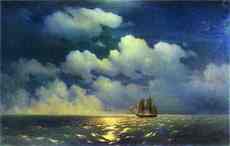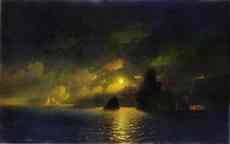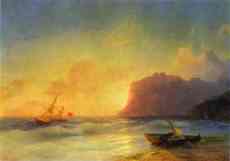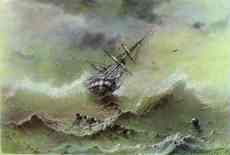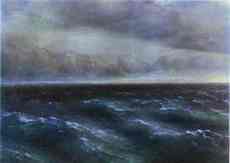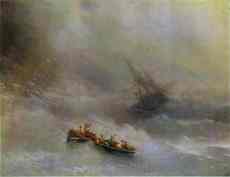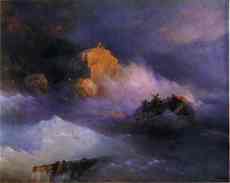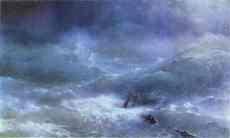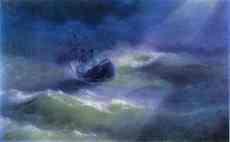これより以下は、画像を参照する「Ivan Aivazovsky - Olga's Gallery 」(ホームページ:「Olga's Gallery 」)でのアイヴァゾフスキーのプロフィール:
← Ivan Aivazovsky. 「Meeting of the Brig Mercury with the Russian Squadron After the Defeat of Two Turkish Battleships.」 1848. Oil on canvas. The Russian Museum, St. Petersburg, Russia..(画像は、「Ivan Aivazovsky - Olga's Gallery 」より)
Ivan Konstantinovich Aivazovsky was born in the family of a merchant of Armenian origin in the town of Feodosia, Crimea. His parents were under strained circumstances and he spent his childhood in poverty. With the help of people who had noticed the talented youth, he entered the Simpheropol gymnasium, and then the St. Petersburg Academy of Arts, where he took the landscape painting course and was especially interested in marine landscapes. In the autumn of 1836 Aivazovsky presented 5 marine pictures to the Academic exhibition, which were highly appreciated. In 1837, Aivazovsky received the Major Gold Medal for Calm in the Gulf of Finland (1836) and The Great Roads at Kronstadt (1836), which allowed him to go on a long study trip abroad. However the artist first went to the Crimea to perfect himself in his chosen genre by painting the sea and views of Crimean coastal towns.
イワン・アイヴァゾフスキーは、フェオドシヤ、クリミアの町のアルメニア系の商人の家族に生まれた。彼の両親は困窮しており、彼は、貧困に苦しむ幼年期を過ごした。若者の才能に気づいた人々の支援によって彼は教育の機会を得、やがてペテルブルク美術アカデミーに入った。そこでは、彼は風景画コースをとり、とりわけ海の景観に惹かれた。1836の秋、アイヴァゾフスキーはアカデミーでの展示会に5つの海洋画を提供し、高い評価を受けた。1837年には、アイヴァゾフスキーは、「Calm in the Gulf of Finland (1836) 」と「The Great Roads at Kronstadt (1836),」の作品で金賞を得た。その結果、彼は外国での長い研究を続けることになった。しかしながら、まずクリミア半島へ行きクリミアの町や海の景色を描くうちに彼はその分野の腕をあげることになった。
→ Ivan Aivazovsky. 「Moonlit Night.」 1849. Oil on canvas. The Russian Museum, St. Petersburg, Russia (画像は、「Ivan Aivazovsky - Olga's Gallery 」より)
During the period of 1840-1844 Aivazovsky, as a pensioner of the Academy of Arts, spent time in Italy, traveled to Germany, France, Spain, and Holland. He worked much and had many exhibitions, meeting everywhere with success. He painted a lot of marine landscapes, which became very popular in Italy: The Bay of Naples by Moonlight (1842), Seashore. Calm (1843), Malta. Valetto Harbour (1844). His works were highly appreciated by J.W.M. Turner, a prominent English landscape and marine painter. In the course of his work, Aivazovsky evolved his own method of depicting the motion of the sea – from memory, without preliminary sketches, limiting himself to rough pencil outlines. Aivazovsky’s phenomenal memory and romantic imagination allowed him to do all this with incomparable brilliance. The development of this new method reflected the spirit of the age, when the ever-increasing romantic tendencies put an artist's imagination to the front.
← Ivan Aivazovsky. 「The Sea. Koktebel.」 1853. Oil on canvas. The Aivazovsky Art Gallery, Feodosia, Ukraine..(画像は、「Ivan Aivazovsky - Olga's Gallery 」より)
1840-1844の期間に、アイヴァゾフスキーは、芸術のアカデメイア学派の年金受給者として、イタリアで過ごし、ドイツ、フランス、スペインおよびオランダへ旅行しました。彼は研鑽を重ね、多くの展示をし到る所で成功した。彼は多くの海の風景画を描きました。それはイタリアで人気を博した。「Bay of Naples by Moonlight (1842)」、「Seashore. Calm (1843)」、「Malta. Valetto Harbour (1844)」。彼の作品はイギリスの名立たる風景画や海の画家であるJ.W.M.ターナーに高く評価された。アイヴァゾフスキーはやがて海の動きを事前にスケッチすることなく、記憶だけで描く技術を磨いた。アイバゾフスキーは、驚異的な記憶力とロマンチックな想像力があればこそ、こうしたことを達成できたのである。こうした新しい方法の開拓は、時代の精神を反映していた。増大してやまぬロマンチシズムの傾向はアイバゾフスキーを時代の最先端に立たせたのだった。
→ Ivan Aivazovsky. 「Storm.」 1854. Papier pele, black lead and crayons. The Russian Museum, St. Petersburg, Russia. (画像は、「Ivan Aivazovsky - Olga's Gallery 」より)
When in 1844 the artist returned to St. Petersburg, he was awarded the title of Academician, and became attached to the General Naval Headquarters. This allowed him to travel much with Russian fleet expeditions on different missions; he visited Turkey, Greece, Egypt, America. From 1846 to 1848 he painted several canvases with naval warfare as the subject; the pictures portrayed historical battles of the Russian Fleet The Battle of Chesme (1848), The Battle in the Chios Channel (1848), Meeting of the Brig Mercury with the Russian Squadron... (1848).
← Ivan Aivazovsky. 「The Black Sea.」 1881. Oil on canvas. The Tretyakov Gallery, Moscow, Russia..(画像は、「Ivan Aivazovsky - Olga's Gallery 」より)
1844年、セントペテルスブルグへ戻った時、アイヴァゾフスキーは学会の会員の肩書きを与えられ、海軍の本部へ配属された。おかげでいろんな使命を帯びたロシア艦隊の遠征で彼がさらにしばしば航海することができた。彼はトルコ、アメリカ・エジプト・ギリシアを訪れた。1846年から1848年まで、彼は海戦を題材にキャンバスを油絵を描いた。その海戦の絵は、ロシア艦隊の歴史上の戦いを描いたもので、「The Battle of Chesme (1848)」「The Battle in the Chios Channel (1848)」「Meeting of the Brig Mercury with the Russian Squadron... (1848)」である。
→ Ivan Aivazovsky. 「The Rainbow.」 1873. Oil on canvas. The Tretyakov Gallery, Moscow, Russia. (画像は、「Ivan Aivazovsky - Olga's Gallery 」より)
Towards the 1850s the romantic features in Aivazovsky’s work became increasingly pronounced. This can be seen quite clearly in one of his best and most famous paintings The Tenth Wave (1850) and also in Moonlit Night (1849), The Sea. Koktebel. (1853), Storm (1854) and others.
1850年代に向けてアイヴァゾフスキーの作品でのロマンチックな特徴は、ますます際立つようになった。こうしたことは、彼の最良で、最も有名な絵画が物語っている。「The Tenth Wave (1850) 」「Moonlit Night (1849)」「The Sea. Koktebel. (1853)」「Storm (1854)」などである。
← Ivan Aivazovsky. 「Shipwreck.」 1876. Oil on canvas. The Aivazovsky Art Gallery, Feodosia, Ukraine.画像は、「Ivan Aivazovsky - Olga's Gallery 」より)
The process, which determined the development of Russian art in the second half of the 19th century, also affected Aivazovsky. A new and consistently realistic tendency appeared in his work, although the romantic features still remained.
19世紀後半のロシアの芸術の展開を決定的なものにした流れはアイヴァゾフスキーにも影響を与えた。ロマンチシズムの特徴はまだ残ってはいたが、新しく、一貫してリアリズムの傾向が彼の作品に現われたのである。
→ Ivan Aivazovsky. 「The Billow.」 1889. Oil on canvas. The Russian Museum, St. Petersburg, Russia. (画像は、「Ivan Aivazovsky - Olga's Gallery 」より)
The artist's greatest achievement of this period is The Black Sea (1881), a picture showing the nature of the sea, eternally alive, always in motion. Other important pictures of the late years are The Rainbow (1873), Shipwreck (1876), The Billow (1889), The Mary Caught in a Storm (1892).
芸術家のこの時期の最も偉大な作品は、「The Black Sea (1881)」である。常に動いて止まない、永遠に生きている海という自然を描いた絵である。晩年の重要な作品は、「The Rainbow (1873)」「Shipwreck (1876)」「The Billow (1889)」「The Mary Caught in a Storm (1892)」である。
← Ivan Aivazovsky. 「The Mary Caught in a Storm.」 1892. Oil on canvas. The Aivazovsky Art Gallery, Feodosia, Ukraine. 画像は、「Ivan Aivazovsky - Olga's Gallery 」より)
Aivazovsky left more than 6000 pictures, which are of very different value. There are masterpieces and there are very timid works. He failed to draw landscapes, could not draw a man. Aivazovsky got good commissions and became rich. He spent much money for charity, especially for his native town, he opened in Feodosia the first School of Arts (in 1865), then the Art Gallery (in 1889). He was a member of Academies of Stuttgart, Florence, Rome and Amsterdam.
アイヴァゾフスキーは6000を超える絵を残した。傑作があるし、つまらない作品もある。彼は景色を描くことに失敗した。彼は人間を描けなかった。アイヴァゾフスキーはたっぷり手数料を貰い、リッチになった。彼は、生まれた町などに慈善金を使った。彼は、フェオドシヤで最初のアートスクールを開設した(1865年)。次に画廊(1889年に)を開いた。彼は、シュツットガルト、フィレンツェ、ローマおよびアムステルダムのアカデミーのメンバーだった。
(07/12/17作)
